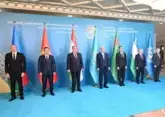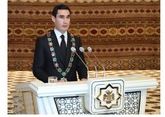The third consultation meeting of Central Asian presidents will be held in Bishkek next year. It had been agreed in Tashkent following the results of the second consultation meeting, which was attended by president of Uzbekistan Shavkat Mirziyoyev, president of Kyrgyzstan Sooronbai Jeenbekov, president of Tajikistan Emomali Rahmon, president of Turkmenistan Gurbanguly Berdimuhamedov and first president of Kazakhstan Nursultan Nazarbayev. A Declaration on Multilateral Cooperation was also signed.
Nothing sensational happened at the Central Asian summit. But no one expected that anyway. This was the second meeting of the Central Asian heads. The first one took place almost a dozen years ago. It's a huge gap for regional politics. All these years, the countries of the region have moved away from each other. Today, the heads of state are taking the first steps towards unification. Resentment, mistrust, misunderstanding and internal conflicts, bursting out sometimes, have hindered the solution of the regional problems.
Now the region has entered a stage of development when each of the countries, after solving its initial tasks of forming a state and building a nation to one degree or another, has embarked on the unification process. There were fundamental changes. In many ways, it became clear that the states cannot deal with a logjam of problems in trade, water-energy, transport-communication, humanitarian and educational spheres in isolation. It is necessary to combine efforts. The meetings in Tashkent were held under the sign of unification, and efforts can be combined only when a constant dialogue is conducted. The speeches of all five heads of delegations were consonant. The same set of threats and challenges that should be met was announced.
The President of Tajikistan stated frightening numbers: out of 13 thousand glaciers located in the mountains of his country, a thousand have disappeared by now. And this comes at a time when up to 60% of Central Asia's water resources are formed on the territory of Tajikistan.
The topic was continued by Kyrgyz president Sooronbai Jeenbekov: "A sharp reduction of glaciers in Kyrgyzstan will have social, economic and environmental impacts for the whole region. I propose to combine our efforts to introduce in Central Asia mutual compensation mechanisms for the accumulation of water resources. We expect the costs of storing, managing and delivering water to be reimbursed."
Turkmen leader Gurbanguly Berdimuhamedov called on Central Asian countries to actively involve Afghanistan in regional projects. At least for the sake of the entire region's stability.
A number of initiatives were made by Elbasy Nursultan Nazarbayev. In particular, he has proposed concluding a five-sided 'Treaty on Good Neighborhood and Cooperation for the Development of Central Asia in the 21st Century'. Holding a meeting of the secretaries of the Security Councils of Central Asian countries next year was also proposed. In addition, Nazarbayev called on the governments of the participating countries to pay attention to the problems related to the high dynamics of demographic development. He also proposed to create a a barrier-free Central Asia by removing obstacles to the movement of goods, services and capital. Among other things, Elbasy invited all heads of state to establish a new holiday on March 15 - Central Asian Day.
The host of the meeting, President of Uzbekistan Shavkat Mirziyoyev drew attention to the fact that the heads of state had a common vision for solving problems and developing cooperation, and put forward a number of other initiatives. In particular, Mirziyoyev proposed to organize the Investment Forum of Central Asian countries in Tashkent, to hold annual meetings of the leaders of the Chambers of Commerce.
The next important direction outlined by Mirziyoyev is strengthening transport interconnectedness and unlocking transit potential of the region. During the meeting it was noted that the transport system of Central Asia should, first of all, ensure well-coordinated communications within the region, as well as effectively serve increasing transit flows using the modern infrastructure being created. Apparently, the pending issue of the construction of the China-Kyrgyzstan-Uzbekistan railway will be resolved in the near future.
The presidents agreed to create a regional Council for Transport Communications, the harmonization of the Program and Agreement on the joint development of the transport system in Central Asia.
Moreover, expanding cooperation in the energy sector, taking into account the long-term interests of the region was noted as well.
Among the most promising areas of cooperation is the realization of the huge tourism potential of Central Asian countries. Mirziyoyev noted the need to form a single, recognizable tourism brand of Central Asia with attractive regional tourism products.
However, some surprises still came into the picture. President of Kazakhstan Kassym-Zhomart Tokaev did not arrive in Tashkent. The day before, he paid an official visit to Kyrgyzstan, where he took part in a CSTO meeting. Nazarbayev arrived in Uzbekistan instead. This created some uncertainty - four presidents and one former or real ruler. In order to avoid future incidents, Nazarbayev was named Honorary Chair of the consultative meeting of the Central Asian leaders.
The summit was not marked by the signing of strategic documents. The presidents limited themselves to signing the Declaration and agreed on regular meetings. For a start, once a year. Director of the Center for Research Initiatives 'Ma'no' Bakhtiyor Ergashev told Vestnik Kavkaza about what was accepted and why it was not useless.
- What is the declaration about?
- The leaders of the Central Asia countries documented that this format is important and necessary. Kyrgyzstan will be the next country to host the summit. The rules for these meetings have been adopted: they will be attended by only presidents. Under this regulation, specific proposals for each meeting will be prepared. A transition to a new level is possible when projects and their implementation will be discussed. By the next Consultative Meeting, the foreign ministers and expert groups will prepare roadmaps for implementing projects in the most important areas: water-energy, transport-communication, trade, humanitarian, educational issues, as well as industrial cooperation. The presidents will oversee the implementation of these works. The regional governments will act as developers and implementers. These meetings will become more practical, more pragmatic.
- Will supranational authorities be created?
- It's too soon to talk about this. We created various organizations and unions with permanent secretariats. We even created a single Central Asian bank. But it was a running ahead. Then the countries only got on their feet and were not ready for integration. The current format is completely different. It is slower, does not give quick results, and we don’t hear strategic statements, we don’t see global programs until 2030-2050. But today there is a better chance of creating more effective projects than those that were created with great fanfare in the early 2000s. The current format takes into account the negative experiences of past years."
- World players present in the region are closely watching the new Central Asian initiative. The summit was held without their participation. Will it cause any suspicion?
- Speaking at the extended meeting, President Mirziyoyev drew attention to the fact that the initiative was not directed against anyone. Some countries of the region are part of the EEU - Kazakhstan, Kyrgyzstan. Others are not. It is not possible for all Central Asian leaders to communicate at this site. Just like in the case of in TURKSOY, which does not include Tajikistan. The same goes to the SCO - Turkmenistan is not a member of this alliance. There is the CIS, but this is a very large organisation and it is not interesting for everyone to discuss regional Central Asian issues. They need their own format. And this format was found. Moreover, it was firmly stated that it was not about creating an organization with supranational structures, there were no claims for integration, just consultative meetings. And this was done taking into account the suspicions existing outside the region regarding the meetings of the five Central Asian leaders.
- Will the consultative meeting's fate depend on a possible change of regional leaders? For example, a presidential election is due to take place in Tajikistan next year. Or, for example, there will be another unexpected revolution in Kyrgyzstan.
- Due to the fact that young states and political systems are subject to bifurcations, such risks exist. But, the joint statement says that it's about presidential meetings. Therefore, whatever changes take place, they should not affect this format. It does not matter whether it's a new president or the old one, was he changed or not, the format is obligatory for the presidents of the countries. Participation in the meetings will be important and necessary for any of them, since it is important for the sustainable future of the Central Asian region.










